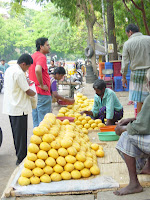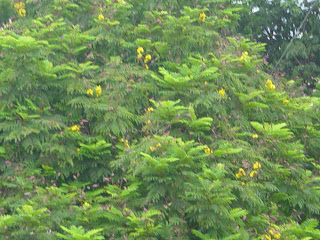Mango Milkshakes, Mommy's Meals and McDonald's
If you enjoyed my other posts in this series on my morning walk and on the Marina Beach, you are likely to also like this entry on food!
 Summer is mango season in Chennai. For a mango-lover like me, it is like visiting paradise. We are enjoying my mom’s mango milkshake, mango lassi, mango pickles, and mango moar-kuzhambu. Discussions about which variety is best (there are hundreds of them) are commonplace at the dinner table. One can never go wrong with the most popular banganapalli but sometimes the heart seeks an imaam pasand, alphonso, malgoa, rumaani, neelam or salem. But there is nothing to beat the joy of plucking the fruit straight from the rooftop terrace of one’s home.
Summer is mango season in Chennai. For a mango-lover like me, it is like visiting paradise. We are enjoying my mom’s mango milkshake, mango lassi, mango pickles, and mango moar-kuzhambu. Discussions about which variety is best (there are hundreds of them) are commonplace at the dinner table. One can never go wrong with the most popular banganapalli but sometimes the heart seeks an imaam pasand, alphonso, malgoa, rumaani, neelam or salem. But there is nothing to beat the joy of plucking the fruit straight from the rooftop terrace of one’s home.
 One Father’s Day, we took my parents-in-law to a trendy, upscale restaurant called Mahamudra. This place had a back-to-nature, organic, home-style feel to it. Apart from the usual ghee dosai, we also ordered items such as vazhaipoo vadai, kuzhakattai, vellappam, and akki roti. These dishes are typically only cooked at home and not served in restaurants. The food at this restaurant was quite pricey but I would rather pay a few more rupees to eat this type of food than what I find at the “malls” in Chennai these days.
One Father’s Day, we took my parents-in-law to a trendy, upscale restaurant called Mahamudra. This place had a back-to-nature, organic, home-style feel to it. Apart from the usual ghee dosai, we also ordered items such as vazhaipoo vadai, kuzhakattai, vellappam, and akki roti. These dishes are typically only cooked at home and not served in restaurants. The food at this restaurant was quite pricey but I would rather pay a few more rupees to eat this type of food than what I find at the “malls” in Chennai these days.
During my visit to one of Chennai’s many big Westernized malls, I wanted to grab a quick snack. I am not brave enough to eat a popular street food called “chaat” from the actual streets. I thought I would stop by a chaat shop called Gangotree in the mall.
Looking around the mall, I noticed that there were two chic upmarket, family restaurants where people go to celebrate– KFC and McDonald’s – ha!! And then there were little shops selling waffles, cookies, crepes, and donuts at exorbitant prices. At the food court there was a coffee shop with muffins and croissants, an Arabian Hut, Little Italy, a Mexican restaurant, and a gelato store. Ignoring them all, I walked steadily towards my favorite chaat shop....but alas, it was now closed. Apparently, Indian food is not trendy enough in India!!
Neoliberal capitalism and globalization comes at a big cost – health. It might come as a surprise to many that South Asians have the highest risk of Type 2 diabetes among all ethnic groups in the United States. I believe our risk rates are up to four times higher than other groups because of genetic and environmental factors. Diabetes has become an epidemic in India too, given the changing lifestyle including eating out a lot, exercising less often etc. This is especially the case in urban India. Similar statistics are seen in other rapidly developing countries such as China and Brazil.
As if this were not enough, South Asians in the United States also have a higher risk of heart disease than almost any other ethnic group. We are at a risk of 2 or 3 times more than the general American population to get heart disease. Much has to do with the lack of exercise and changing food habits.
I am currently working with Dr. Ranjita Misra and Marissa Doshi on a research study that explores how the process of moving to a new culture (acculturation) influences communication as well as health amongst South Asians. It is a fascinating project with data collected from all over the U.S.
For an insider-outsider like me who is visiting India from Texas – the land of big everything including obesity and diabetes – it is striking to notice that as we become more “developed” and “Westernized,” we are eating more fatty foods and in larger portion sizes. Eating out at restaurants has become the norm rather than an occasional outing in urban India. I wish we could adopt more life-serving values such as cleanliness, punctuality, accountability from of contemporary American/European cultures.
Good health, peace and love to all from the land of mangoes, Marina beach and …..McDonald’s!
 Summer is mango season in Chennai. For a mango-lover like me, it is like visiting paradise. We are enjoying my mom’s mango milkshake, mango lassi, mango pickles, and mango moar-kuzhambu. Discussions about which variety is best (there are hundreds of them) are commonplace at the dinner table. One can never go wrong with the most popular banganapalli but sometimes the heart seeks an imaam pasand, alphonso, malgoa, rumaani, neelam or salem. But there is nothing to beat the joy of plucking the fruit straight from the rooftop terrace of one’s home.
Summer is mango season in Chennai. For a mango-lover like me, it is like visiting paradise. We are enjoying my mom’s mango milkshake, mango lassi, mango pickles, and mango moar-kuzhambu. Discussions about which variety is best (there are hundreds of them) are commonplace at the dinner table. One can never go wrong with the most popular banganapalli but sometimes the heart seeks an imaam pasand, alphonso, malgoa, rumaani, neelam or salem. But there is nothing to beat the joy of plucking the fruit straight from the rooftop terrace of one’s home.
My Monday dinners are typically fruit-meals. Being in Chennai on a Monday was a great time for me to experience some lesser known tropical fruits. The fragrant palaa pazham (jack fruit or durian), naaga pazham (deep purple wild berries), mangosteen and nongu. I also like guavas, litchis, and Indian wild pears. But they were not part of my meal this time.

Of my mother’s many talents, cooking is very high on the list. Every meal is exceptional in choice of vegetables, the menu plan, taste, and presentation. She tries to include tropical veggies such as banana stem and drumsticks that are hard to find in the U.S. Although plantains can be found in some backyards in Texas, South Indians’ love for every part of the plantain plant is unrivalled.

Of my mother’s many talents, cooking is very high on the list. Every meal is exceptional in choice of vegetables, the menu plan, taste, and presentation. She tries to include tropical veggies such as banana stem and drumsticks that are hard to find in the U.S. Although plantains can be found in some backyards in Texas, South Indians’ love for every part of the plantain plant is unrivalled.
 One Father’s Day, we took my parents-in-law to a trendy, upscale restaurant called Mahamudra. This place had a back-to-nature, organic, home-style feel to it. Apart from the usual ghee dosai, we also ordered items such as vazhaipoo vadai, kuzhakattai, vellappam, and akki roti. These dishes are typically only cooked at home and not served in restaurants. The food at this restaurant was quite pricey but I would rather pay a few more rupees to eat this type of food than what I find at the “malls” in Chennai these days.
One Father’s Day, we took my parents-in-law to a trendy, upscale restaurant called Mahamudra. This place had a back-to-nature, organic, home-style feel to it. Apart from the usual ghee dosai, we also ordered items such as vazhaipoo vadai, kuzhakattai, vellappam, and akki roti. These dishes are typically only cooked at home and not served in restaurants. The food at this restaurant was quite pricey but I would rather pay a few more rupees to eat this type of food than what I find at the “malls” in Chennai these days.During my visit to one of Chennai’s many big Westernized malls, I wanted to grab a quick snack. I am not brave enough to eat a popular street food called “chaat” from the actual streets. I thought I would stop by a chaat shop called Gangotree in the mall.
Looking around the mall, I noticed that there were two chic upmarket, family restaurants where people go to celebrate– KFC and McDonald’s – ha!! And then there were little shops selling waffles, cookies, crepes, and donuts at exorbitant prices. At the food court there was a coffee shop with muffins and croissants, an Arabian Hut, Little Italy, a Mexican restaurant, and a gelato store. Ignoring them all, I walked steadily towards my favorite chaat shop....but alas, it was now closed. Apparently, Indian food is not trendy enough in India!!
Neoliberal capitalism and globalization comes at a big cost – health. It might come as a surprise to many that South Asians have the highest risk of Type 2 diabetes among all ethnic groups in the United States. I believe our risk rates are up to four times higher than other groups because of genetic and environmental factors. Diabetes has become an epidemic in India too, given the changing lifestyle including eating out a lot, exercising less often etc. This is especially the case in urban India. Similar statistics are seen in other rapidly developing countries such as China and Brazil.
As if this were not enough, South Asians in the United States also have a higher risk of heart disease than almost any other ethnic group. We are at a risk of 2 or 3 times more than the general American population to get heart disease. Much has to do with the lack of exercise and changing food habits.
I am currently working with Dr. Ranjita Misra and Marissa Doshi on a research study that explores how the process of moving to a new culture (acculturation) influences communication as well as health amongst South Asians. It is a fascinating project with data collected from all over the U.S.
For an insider-outsider like me who is visiting India from Texas – the land of big everything including obesity and diabetes – it is striking to notice that as we become more “developed” and “Westernized,” we are eating more fatty foods and in larger portion sizes. Eating out at restaurants has become the norm rather than an occasional outing in urban India. I wish we could adopt more life-serving values such as cleanliness, punctuality, accountability from of contemporary American/European cultures.
Good health, peace and love to all from the land of mangoes, Marina beach and …..McDonald’s!






Comments
Post a Comment